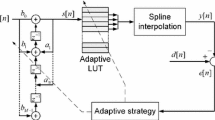Abstract
In the aeroelastic analysis of flight vehicles with electromechanical actuators (EMAs), an accurate prediction of flutter requires dynamic stiffness characteristics of the EMA. The dynamic stiffness transfer function of the EMA with brushless direct current (BLDC) motor can be obtained by conducting complicated mathematical calculations of control algorithms and mechanical/electrical nonlinearities using linearization techniques. Thus, system identification approaches using experimental data, as an alternative, have considerable advantages. However, the test setup for system identification is expensive and complex, and experimental procedures for data collection are time-consuming tasks. To obtain the dynamic stiffness transfer function, this paper proposes a linear system identification method that uses information obtained from a reliable dynamic stiffness model with a control algorithm and nonlinearities. The results of this study show that the system identification procedure is compact, and the transfer function is able to describe the dynamic stiffness characteristics of the EMA. In addition, to verify the validity of the system identification method, the simulation results of the dynamic stiffness transfer function and the dynamic stiffness model were compared with the experimental data for various external loads.









Similar content being viewed by others
Abbreviations
- \(B_i , B_\mathrm{m} , B_\mathrm{s} \) :
-
Damping coefficients of spur gears (\(i = 1, 2)\), BLDC motor, and output shaft, \(\hbox {N}~ \hbox {m/(deg/s)}\)
- \(\mathrm{Fr}_i , \mathrm{Fr}_\mathrm{m} , \mathrm{Fr}_\mathrm{s}\) :
-
Coulomb friction coefficients of spur gears (\(i = 1, 2\)), BLDC motor, and output shaft, \(\hbox {N}~ \hbox {m}\)
- \(i_{ds} , i_{qs}\) :
-
d-axis and q-axis currents of BLDC motor, A
- \(J_i , J_\mathrm{m} , J_\mathrm{s}\) :
-
Moments of inertia of gears (\(i=1,{\ldots },5\)), BLDC motor, and output shaft, \(\hbox {kg}~\hbox {m}^{2}\)
- \(K_\mathrm{B}\) :
-
Back electromotive force constant of BLDC motor, V/(deg/s)
- \(K_i , K_\mathrm{s} \) :
-
Static stiffnesses of components within gear train (\(i = 1, 2\)) and output shaft, \(\hbox {N}~\hbox {m/deg}\)
- \(K_\mathrm{T}\) :
-
Torque constant of BLDC motor, \(\hbox {N}~\hbox {m/A}\)
- \(L_{d} , L_{q}\) :
-
d-axis and q-axis inductances of BLDC motor, H
- \(N_i\) :
-
Gear ratio within gear train (\(i = 1, 2, 3\))
- P :
-
Number of poles of BLDC motor
- \(r_\mathrm{s}\) :
-
Stator resistance of BLDC motor, \(\Omega \)
- \(T_\mathrm{L}\) :
-
Load into BLDC motor, \(\hbox {N}~\hbox {m}\)
- \(T_{\mathrm{{load}}}\) :
-
External load into output shaft of electromechanical actuator, \(\hbox {N}~\hbox {m}\)
- \(T_\mathrm{m} \) :
-
Motor output torque, \(\hbox {N}~ \hbox {m}\)
- \(\eta _i \) :
-
Efficiencies of spur gears (\(i = 1, 2\)) and worm gear (\(i = 3\))
- \(\theta _\mathrm{m} , \theta _{i} , \theta _{\mathrm{gt}} , \theta _\mathrm{s} \) :
-
Deflection angles of BLDC motor, gears (\(i = 1, 2\)) in gear train, gear train, and output shaft of electromechanical actuator, deg
- \(\lambda _{ds} , \lambda _{qs} \) :
-
d-axis and q-axis flux linkages of BLDC motor, \(\hbox {V}~\hbox {s}\)
- \(\lambda _\mathrm{m} \) :
-
Magnitude of flux linkage established by permanent magnet, \(\hbox {V}~\hbox {s}\)
- \(v_{ds} , v_{qs} \) :
-
d-axis and q-axis voltages of BLDC motor, V
- \(\omega _\mathrm{r} \) :
-
Electrical angular velocity of BLDC motor, deg/s
References
Karpel M (1981) Design for active and passive flutter suppression and gust alleviation, NASA CR-3482. https://ntrs.nasa.gov/search.jsp?R=19820005274. Accessed 1 Dec 2016
Danowsky B, Thompson PM, Kukreja S (2013) Nonlinear analysis of aeroservoelastic models with free play using describing functions. J Aircr 50(2):329–336. https://doi.org/10.2514/1.C031370
Yang N, Wu Z, Yang C (2011) Structural nonlinear flutter characteristics analysis for an actuator-fin system with dynamic stiffness. Chin J Aeronaut 24(5):590–599. https://doi.org/10.1016/S1000-9361(11)60069-1
Kim JY, Kim KS, Lee I, Park YK (2008) Transonic aeroelastic analysis of all-movable wing with free play and viscous effects. J Aircr 45(5):1820–1824. https://doi.org/10.2514/1.37435
Shin WH, Lee I, Shin YS, Bae JS (2007) Nonlinear aeroelastic analysis for a control fin with an actuator. J Aircr 44(2):597–605. https://doi.org/10.2514/1.24721
Bae JS, Kim DK, Shin WH, Lee I, Kim SH (2004) Nonlinear aeroelastic analysis of a deployable missile control fin. J Spacecr Rockets 41(2):264–271. https://doi.org/10.2514/1.1052
Morino H, Obayashi S (2015) Nonlinear aeroelastic analysis of control surface with freeplay using computational-fluid-dynamics-based reduced-order models. J Aircr 52(2):569–583. https://doi.org/10.2514/1.C032775
Kim SH, Tahk MJ (2016) Modeling and experimental study on the dynamic stiffness of an electromechanical actuator. J Spacecr Rockets 53(4):708–719. https://doi.org/10.2514/1.A33483
Krause PC, Wasynczuk O, Sudhoff SD (2002) Analysis of electric machinery and drive systems, 2nd edn. IEEE Press, Wiley-Interscience, New York
Blaignan VB, Skormin VA (1993) Stiffness enhancement of flight control actuator. IEEE Trans Aerosp Electron Syst 29(2):380–390. https://doi.org/10.1109/7.210076
Zhang XT, Wu ZG, Yang C (2013) New flutter-suppression method for a missile fin with an actuator. J Aircr 50(3):989–994. https://doi.org/10.2514/1.C031961
Suykens J, Horvath G, Basu S, Micchelli C, Vandewalle J (eds) (2003) Advances in learning theory: methods, models and applications. NATO Science Series III: Computer & Systems Sciences, vol 190. IOS Press, Amsterdam
Mahmoud MS (2011) Linear identification of a steam generation plant. In: Proceedings of the world congress on engineering, London, vol III, pp 2457–2465
Ljung L (1999) System identification: theory for the user, 2nd edn. Prentice Hall PTR, New Jersey
Author information
Authors and Affiliations
Corresponding author
Rights and permissions
About this article
Cite this article
Kim, S.H., Tahk, MJ. Dynamic Stiffness Transfer Function of an Electromechanical Actuator Using System Identification. JASS 19, 208–216 (2018). https://doi.org/10.1007/s42405-018-0005-7
Received:
Revised:
Accepted:
Published:
Issue Date:
DOI: https://doi.org/10.1007/s42405-018-0005-7




